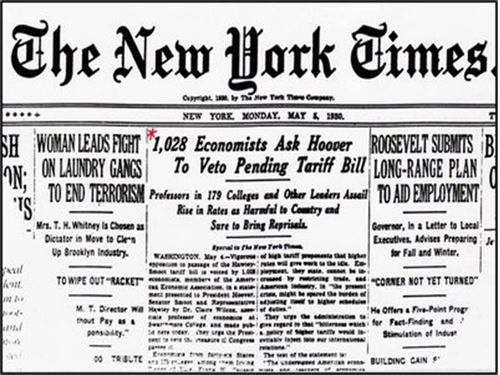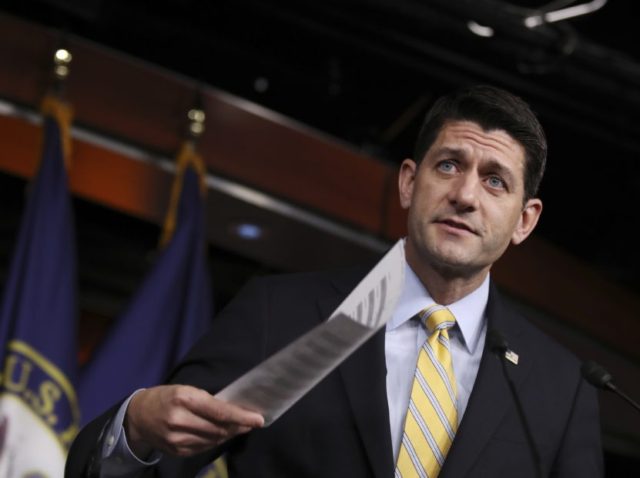This morning’s key headlines from GenerationalDynamics.com
- Washington tax reform plans may include a ‘Border Adjustment Tax’
- Historical comparison with the 1930 Smoot-Hawley Tariff Bill
Washington tax reform plans may include a ‘Border Adjustment Tax’

NY Times, May 5, 1930 – over a thousand economists opposed the Smoot-Hawley Tariff Bill (History Hub)
News reports indicate that Congressional Republicans, led by House Speaker Paul Ryan, are considering a “border adjustment tax” as one of the proposals for the tax reforms plans this year.
The details are vague, but it appears that the proposal is essentially an indirect tariff, using taxes charged to certain companies to raise prices of imported products, and tax reductions to other companies to encourage exports. It is especially targeting American companies that close factories in the U.S. and open factories in Mexico or other countries, and then import the products manufactured in those factories back into the United States.
There appear to be two major objectives. One is to generate revenue to pay for other parts of the tax reform package. And the second is to discourage companies from moving factories and jobs to other countries.
President Trump has not endorsed the idea, but on Thursday seemed to favor it:
It could lead to a lot more jobs in the United States… I certainly support a form of tax on the border. What is going to happen is companies are going to come back here, they’re going to build their factories and they’re going to create a lot of jobs and there’s no tax.
Historical comparison with the 1930 Smoot-Hawley Tariff Bill
In 1930, the Smoot-Hawley Tariff Bill was passed, increasing import tariffs on some 900 products. The 1929 stock market panic, and the subsequent loss of many families’ life savings, was blamed by the public on foreign banks and companies, and it was widely believed that the tariffs would save American jobs. Except for a few details, the public mood then is similar to the public mood today.
In my 2003 book, “Generational Dynamics – Forecasting America’s Destiny,” which is available as a free PDF from my download page, http://generationaldynamics.com/download, I wrote the following about the Smoot-Hawley bill:
Perfectly reasonable acts by one country can be interpreted as hostile acts by another country. Guns and bombs are not needed to create an impression of war.
And if one country’s innocent act is a shock to another country and is viewed as hostile by that country, and if the people of that country are in a mood for retribution rather than compromise, than they may well look for a way to retaliate.
In that sense, the enactment of the Smoot-Hawley Tariff Act in June 1930, can be viewed as the first of the shocking, provocative acts that led to World War II.
The Act was opposed by an enormous number of economists as being harmful to everyone, but it was very popular with the public, because of the perception that it would save American jobs…
Interestingly, the Smoot-Hawley Act is still debated by politicians today, with regard to whether it caused or aggravated the Great Depression or had no effect…
Those discussions are entirely America-centric because, for the purposes of this book, it makes no difference whatsoever whether or not the Act aggravated the American depression. We’re interested in the effect it had on foreign nations.
And the effects were enormous. The bill erected large trade barriers for numerous products, with the intention of saving American jobs. How many American jobs it saved, if any, is unknown, but it virtually shut down product exports to the United States. Both Germany and Japan were going through the same financial crisis America was going through, and they were furious that America as a market was closed to them.
Japan was the hardest hit. The Great Depression was hurting Japan just as much as it was hurting America but, in addition, Japan’s exports of its biggest cash crop, silk, to America were almost completely cut off by the Smoot-Hawley Act. Furthermore, Japan would have been going through a generational change: The country had undergone a historic revolution some 70+ years earlier, culminating in a major change of government (the Meiji Restoration) in 1868, and the people who had lived through that revolution would be dead or retiring by the early 1930s.
So one thing led to another, and in September 1931, almost exactly a year after Smoot-Hawley, Japan invaded Manchuria and later northern China. Britain and American strongly protested this aggression, and Roosevelt finally responded with an oil embargo against Japan.
This is the usual pattern of provocative acts on both sides. America saw Smoot-Hawley as its own business, but to Japan it was a hostile shock. Japan saw the Manchuria invasion as “Asian business,” while Britain and America saw it as attacking their own Asian interests. Roosevelt saw an oil embargo as a measured response of containment, while energy-dependent Japan saw it almost as an act of war, eventually triggering Japan’s attack on Pearl Harbor in 1941.
Japan wasn’t the only country affected, of course. England, Germany, Italy, and many other countries were hit hard by the sudden trade barriers with America. Just like in Japan, nationalistic and militaristic feelings were aroused in many countries.
Germany was especially frustrated. The map of Central Europe had been redrawn some 70 years earlier during a series of wars in the 1860s, culminating in the Franco-Prussian war of 1870, and the unification of Germany in 1871. The Great War (WW I) had been a mid-cycle war for Germany, and had been a humiliating defeat, especially because the American and British led Allies had imposed harsh conditions — the loss of some German-speaking territories, and the payment of reparations. The loss of territories was especially provocative, since it partially reversed the German unification of 1871.
Germany was reaching the point where it was going to explode anyway, when the Smoot-Hawley Act was passed. On top of the reparations, the Act was seen as enormously hostile by the Germans. As in Japan, it gave rise to militaristic nationalism in the form of the rise of the Nazis. Germany remilitarized its border with France in 1936, and then annexed German-speaking parts of Eastern Europe in 1938.
So when did World War II start? It depends on what the word “start” means, but an argument can be made that America had started the war, and that the first act of war was the Smoot-Hawley Tariff Act.
I wrote the above in 2003, so it should not surprise anyone that today I consider the proposed “border adjustment tax” to be a very dangerous idea.
A recent blog post by economists at the New York Fed claims that the proposed tax will have little effect on either imports or exports, which means little effect on revenue or jobs. But whether or not that’s true is irrelevant to this discussion.
As in the case of the Smoot-Hawley bill, the main issue is not the effect on the US, but the effect on other nations. Any such border tax would quickly raise nationalist feelings in other nations. There would be retaliatory tariffs enacted in other countries. Some countries might be severely damaged economically, and even if they’re not, they would blame any economic problems they have on the American tariffs, and might look for even more far-reaching forms of retaliation.
Some people might argue that the proposed “border adjustment tax” is so small and so limited that it could not possibly have such a negative effect. Once again we can look to history to see whether that’s true. According to an article in the June 21, 1930, issue of The Economist:
The signature by President Hoover of the Hawley-Smoot Tariff Bill at Washington is the tragi-comic finale to one of the most amazing chapters in world tariff history, and it is one that protectionist enthusiasts the world over would do well to study. The reason for tariff revision was a desire to restore a balance of protection which had been tilted to the disadvantage of the agriculturalist. But so soon as ever the tariff schedules were cast into the melting-pot of revision, log-rollers and politicians set to work stirring with all their might, and a measure which started with the single
object of giving satisfaction to the farmer emerges as a full-fledged high tariff act in which nearly 900 duties have been raised, some extravagantly. Such is the inevitable result of vested interests working through political influence, ending in signature by a president, antagonistic to the bill, under compulsion of political necessities.
So the original Smoot-Hawley bill was to be very small, just providing a little protection to farmers, but once the door was opened, the bill exploded.
The same thing would happen today. Congress would be inundated with high-paid lobbyists from all sorts of industries demanding that their products be “protected” by the border adjustment tax. History tells us that that the final bill would be a hodge-podge of special interests and industries, with few winners but lots of losers, and a great deal of nationalistic fury in many other countries.
The proposal for even a “small” border adjustment tax starts us down a path that can lead to the same kind of disaster that the 1930 Smoot-Hawley Act caused. New York Fed Blog and Economist (18-Dec-2008) and Economist (21-Jun-1930) and History Hub and Generational Dynamics – Forecasting America’s Destiny (PDF)
Related Articles
- Japan’s Shinzo Abe blames WW II on the Smoot-Hawley Tariff act (15-Aug-2015)
- The bubble that broke the world (09-Oct-2007)
- Explanation of Price/Earnings ratio and Stock Valuations (28-Aug-2015)
KEYS: Generational Dynamics, border adjustment tax, Paul Ryan, Smoot-Hawley Tariff Bill, Herbert Hoover, Germany, Japan
Permanent web link to this article
Receive daily World View columns by e-mail

COMMENTS
Please let us know if you're having issues with commenting.